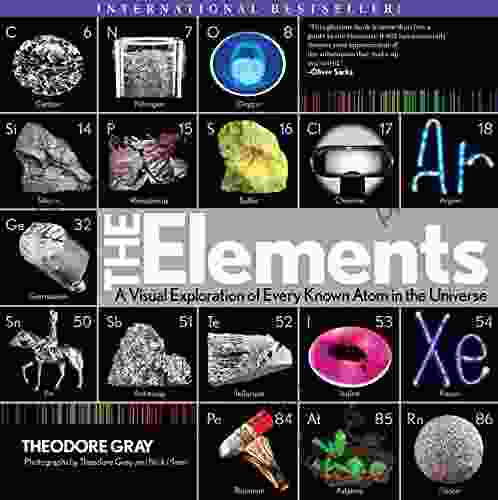Visual Exploration Of Every Known Atom In The Universe

Preamble
The universe, an enigmatic tapestry of celestial wonders, is composed of a myriad of fundamental building blocks: atoms. These minuscule particles, the essence of all matter, possess a mesmerizing beauty and profound significance that has intrigued scientists and captivated the human imagination for centuries.
Embarking on an unparalleled visual odyssey, this extraordinary exploration invites you to delve into the atomic realm and uncover the hidden wonders of every known element in the universe. Through stunning infographics, captivating imagery, and thought-provoking insights, we present a comprehensive journey that unveils the intricate structures, fascinating properties, and historical significance of these elemental building blocks.
4.8 out of 5
| Language | : | English |
| File size | : | 60400 KB |
| Text-to-Speech | : | Enabled |
| Screen Reader | : | Supported |
| Enhanced typesetting | : | Enabled |
| Print length | : | 241 pages |
Prepare to be awestruck as we traverse the periodic table, encountering the noble gases, the volatile halogens, the reactive alkali metals, and the enigmatic transition metals. Each element reveals a unique story, a testament to the boundless creativity and diversity of the cosmos.
Hydrogen: The Primordial Seed
Our odyssey commences with hydrogen, the most abundant element in the universe, a ubiquitous presence in stars, planets, and the interstellar medium. Its simplicity belies its profound importance, serving as the primordial seed from which all other elements were forged in the fiery crucible of the Big Bang. Hydrogen's lone proton and electron dance in a harmonious embrace, creating the foundation for the atomic world.
Helium: The Cosmic Jester
Next, we encounter helium, the second lightest element, a playful cosmic jester that fills the celestial balloons of stars and giant planets. Its nucleus, composed of two protons and two neutrons, exhibits a stability that renders it inert, an enigmatic loner in the atomic realm. Helium's whimsical nature manifests in its unique properties, including its ability to liquefy at extremely low temperatures, creating a surreal, superfluid realm.
Lithium: The Cosmic Archaeologist
Lithium, the third element on our journey, is a cosmic archaeologist, bearing witness to the earliest moments of the universe's existence. Its presence in ancient stars reveals clues about the primordial conditions that shaped our cosmos. Lithium's nucleus, containing three protons and four neutrons, possesses a delicate balance, making it susceptible to nuclear reactions that forge heavier elements in the stellar furnaces.
Beryllium: The Lightweight Champion
Beryllium, a lightweight champion among the elements, possesses an unusual combination of strength and lightness. Its nucleus, consisting of four protons and five neutrons, exhibits a remarkable stability that defies its small size. Beryllium's unique properties make it an ideal material for aerospace applications, where its exceptional strength-to-weight ratio proves invaluable.
Boron: The Versatile Shapeshifter
Boron, a versatile shapeshifter in the atomic realm, assumes diverse forms depending on its surroundings. Its nucleus, comprising five protons and six neutrons, can adopt various configurations, giving rise to a range of allotropes with distinct properties. Boron's chameleon-like behavior makes it an essential ingredient in a myriad of industrial and technological applications, including semiconductors, glass, and fertilizers.
Carbon: The Foundation of Life
Carbon, the cornerstone of all known life forms, emerges as the most versatile element in the universe. Its ability to form intricate molecular bonds with itself and other elements gives rise to an astonishing diversity of molecules, essential for biological processes and the very fabric of life. Carbon's nucleus, containing six protons and six neutrons, serves as the foundation for the vast tapestry of organic chemistry, the language of life itself.
Nitrogen: The Atmospheric Giant
Nitrogen, the enigmatic giant, comprises approximately 78% of Earth's atmosphere, a vast reservoir of this essential element. Its nucleus, composed of seven protons and seven neutrons, showcases a remarkable stability, making it an inert gas under ordinary conditions. Nitrogen plays a pivotal role in biological processes, forming the backbone of proteins and nucleic acids, the blueprints of life.
Oxygen: The Breath of Life
Oxygen, the vivifying force, sustains all aerobic life on Earth. Its nucleus, containing eight protons and eight neutrons, exhibits a unique reactivity that enables it to form diverse compounds with other elements. Oxygen's vital role in respiration makes it the breath of life, essential for the survival of countless organisms across the globe.
Fluorine: The Reactive Enigma
Fluorine, the most reactive of all elements, possesses a fiery personality that belies its small size. Its nucleus, comprising nine protons and ten neutrons, harbors an unquenchable thirst for electrons, making it highly reactive and corrosive. Fluorine's unique properties find applications in diverse fields, including nuclear energy, medicine, and the production of fluorinated materials.
Neon: The Inert Glow
Neon, an enigmatic element with a captivating glow, stands out as the epitome of inertness. Its nucleus, containing ten protons and ten neutrons, exhibits an exceptional stability that renders it unreactive under ordinary conditions. Neon's unique properties make it ideal for use in lighting applications, where its unmistakable reddish-orange glow illuminates cities and captivates the human eye.
Sodium: The Ubiquitous Alkali Metal
Sodium, a ubiquitous alkali metal, plays a vital role in biological processes, regulating fluid balance and nerve impulses. Its nucleus, containing eleven protons and twelve neutrons, possesses a single valence electron, making it highly reactive and prone to forming ionic bonds. Sodium's abundance in Earth's crust and its essential role in life make it an indispensable element in the grand scheme of things.
Magnesium: The Lightweight Colossus
Magnesium, a lightweight colossus among the elements, combines strength and lightness, making it an ideal material for aerospace and automotive applications. Its nucleus, comprising twelve protons and twelve neutrons, exhibits a remarkable stability, contributing to its exceptional durability and resistance to corrosion. Magnesium's versatility extends to biological systems, where it plays a crucial role in enzyme function and energy production.
Aluminum: The Versatile Metal
Aluminum, a versatile metal with a silvery-white luster, finds applications in a myriad of industries, from aerospace to construction. Its nucleus, containing thirteen protons and fourteen neutrons, possesses a unique combination of strength, lightness, and corrosion resistance. Aluminum's ability to form strong alloys and its ease of fabrication make it a preferred material for a wide range of products, including aircraft, vehicles, and building materials.
Silicon: The Digital Backbone
Silicon, the cornerstone of modern technology, forms the foundation of semiconductors, the essential building blocks of computers and electronic devices. Its nucleus, containing fourteen protons and fourteen neutrons, exhibits a remarkable ability to control the flow of electrons, making it ideal for transistors and integrated circuits. Silicon's role in the digital revolution has transformed the way we live, work, and communicate, shaping the modern world in countless ways.
Phosphorus: The Energy Carrier
Phosphorus, an essential element for life, plays a pivotal role in energy storage and transfer. Its nucleus, containing fifteen protons and sixteen neutrons, harbors a unique ability to form high-energy bonds, making it a crucial component of ATP, the primary energy currency of cells. Phosphorus's significance extends to biological membranes and genetic material, underscoring its indispensable nature in the intricate tapestry of life.
Sulfur: The Versatile Nonmetal
Sulfur, a versatile nonmetal with a pungent odor, exhibits a wide range of properties, making it an essential
4.8 out of 5
| Language | : | English |
| File size | : | 60400 KB |
| Text-to-Speech | : | Enabled |
| Screen Reader | : | Supported |
| Enhanced typesetting | : | Enabled |
| Print length | : | 241 pages |
Do you want to contribute by writing guest posts on this blog?
Please contact us and send us a resume of previous articles that you have written.
 Book
Book Novel
Novel Page
Page Chapter
Chapter Text
Text Story
Story Genre
Genre Reader
Reader Library
Library Paperback
Paperback E-book
E-book Magazine
Magazine Newspaper
Newspaper Paragraph
Paragraph Sentence
Sentence Bookmark
Bookmark Shelf
Shelf Glossary
Glossary Bibliography
Bibliography Foreword
Foreword Preface
Preface Synopsis
Synopsis Annotation
Annotation Footnote
Footnote Manuscript
Manuscript Scroll
Scroll Codex
Codex Tome
Tome Bestseller
Bestseller Classics
Classics Library card
Library card Narrative
Narrative Biography
Biography Autobiography
Autobiography Memoir
Memoir Reference
Reference Encyclopedia
Encyclopedia Elmer Keith
Elmer Keith John P Kotter
John P Kotter Erez Cohen
Erez Cohen Ruth Wilshaw
Ruth Wilshaw Juan Antonio Fernandez
Juan Antonio Fernandez Emily Crafts
Emily Crafts Michele Stanten
Michele Stanten Elaine Heney
Elaine Heney Lisa Fain
Lisa Fain Philip B Meggs
Philip B Meggs Ella Clark
Ella Clark Emmanuel Mwembwa
Emmanuel Mwembwa Julie Ertz
Julie Ertz Emily Tamkin
Emily Tamkin Elizabeth Field
Elizabeth Field Ramsay Burt
Ramsay Burt Eliza Hof
Eliza Hof Einat L K
Einat L K Eric Rouleau
Eric Rouleau Kristen Stein
Kristen Stein
Light bulbAdvertise smarter! Our strategic ad space ensures maximum exposure. Reserve your spot today!

 Percy Bysshe ShelleyThe Enchanting World of Leonardo da Vinci's Paintings: A Masterpiece Journey
Percy Bysshe ShelleyThe Enchanting World of Leonardo da Vinci's Paintings: A Masterpiece Journey Randy HayesFollow ·8.6k
Randy HayesFollow ·8.6k J.R.R. TolkienFollow ·14k
J.R.R. TolkienFollow ·14k Dennis HayesFollow ·18.9k
Dennis HayesFollow ·18.9k Mikhail BulgakovFollow ·8.7k
Mikhail BulgakovFollow ·8.7k Cruz SimmonsFollow ·8.2k
Cruz SimmonsFollow ·8.2k Alfred RossFollow ·8.5k
Alfred RossFollow ·8.5k Jorge AmadoFollow ·4.7k
Jorge AmadoFollow ·4.7k Pablo NerudaFollow ·2.1k
Pablo NerudaFollow ·2.1k

 Richard Adams
Richard AdamsGame Development with Rust and WebAssembly: A...
Are you passionate...

 David Baldacci
David BaldacciGendered Identity and Aspiration on the Globalized Shop...
: The Convergence of Gender, Identity, and...

 Natsume Sōseki
Natsume SōsekiFresh Eyes On Panama: A Captivating Exploration of a...
Panama, a country often overshadowed by its...

 Adrian Ward
Adrian WardThe Life and Masterworks of J.M.W. Turner: A Timeless...
The Man Behind the Masterpieces ...
4.8 out of 5
| Language | : | English |
| File size | : | 60400 KB |
| Text-to-Speech | : | Enabled |
| Screen Reader | : | Supported |
| Enhanced typesetting | : | Enabled |
| Print length | : | 241 pages |














